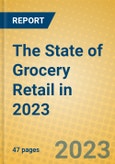As the pandemic-driven surge in grocery sales subsides, grocery retailers must contend with an increasingly complex macroeconomic environment and heightened consumer expectations. This report delves into the evolution of the global grocery retail sector in 2023, examining how various retailers are addressing current industry challenges.
The The State of Grocery Retail in 2023 global briefing offers an insight into the size and shape of the retailing industry, highlights emerging trends, their effects on retailing in markets around the world, on the development of channels and consumers’ shopping patterns. It identifies the leading companies and brands, offers strategic analysis of key factors influencing the market - be they the developments of new store types, the importance of non-store retailing, economic/lifestyle influences, private label or pricing issues. Forecasts illustrate how the market is set to change and criteria for success.
Product coverage: Retail E-Commerce, Retail Offline.
Data coverage: market sizes (historic and forecasts), company shares, brand shares and distribution data.
Key Findings
In 2023, the global grocery retail sector aims to recover from an unusually bad year
In 2022, as high rates of inflation battered consumers in Europe, the Americas, Africa and Australasia – and as the economy of China, relatively unaffected by inflation, stumbled due to other factors – the global grocery retail sector took a hit, posting an absolute dollar sales decline, in constant terms, for the first time in decades.
Grocery e-commerce and warehouse clubs are bucking the downturn
Value- and convenience-focused grocery channels are performing better, on a relative basis, than others, but two channels in particular – grocery e-commerce and warehouse clubs – stand out from the rest. Warehouse clubs, in particular, is doing brisk business, as the channel’s marriage of low unit prices and middle-class cachet proves especially appealing.
Consumers are forcing grocery retailers to move beyond being “omnichannel”
In 2023, nearly all grocery retailers of any size have adopted digital strategies. This shift is not only due to an increase in online grocery sales powered by changing consumption patterns. It is also occurring because consumers now consider e-commerce fulfilment options like delivery and click-and-collect to be essential offerings rather than unique perks.
Grocery retailers increasingly live and die by their ability to manage four factors
As the global grocery retail sector faces new challenges due to an uncertain macroeconomic outlook, intensifying competition, the rapid pace of digitalisation, and increasingly demanding consumers, the success and failure of players in the space will hinge, more than ever before, on their ability to manage four factors: cost, user experience, supply chain optimisation, and scale.
Grocery retail is poised to return to growth, but small players face new challenges
The essential nature of grocery retail means it is hard to keep the sector down for very long. As a result, sales growth is projected to again be positive – though low – in 2023. Yet, as other factors converge to make grocery retail a more challenging enterprise than ever, small players in the space are increasingly in danger of being pushed out by larger, better capitalised rivals.
Why buy this report?
- Get a detailed picture of the Retail market
- Pinpoint growth sectors and identify factors driving change
- Understand the competitive environment, the market’s major players and leading brands
- Use five-year forecasts to assess how the market is predicted to develop








